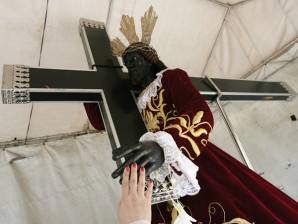Black Nazarene procession: Hopefully faster, safer, cleaner, sober

SHELTERING SEÑOR A replica of the iconic Black Nazarene is housed in a tent outside Quiapo church in Manila on Thursday, ahead of the Jan. 9 grand procession that is expected to draw six to eight million devotees. NIÑO JESUS ORBETA
To avoid a repeat of last year’s procession that took 22 hours to finish, the carriage that will bear the iconic image of the Black Nazarene of Quiapo has been redesigned for smoother, faster movement amid crushing waves of barefoot devotees, officials said on Thursday.
Monsignor Clemente Ignacio, rector of the Minor Basilica of the Black Nazarene in Manila, said organizers expect 6 to 8 million worshippers to attend the grand procession from Rizal Park to the statue’s sanctuary in Quiapo on Jan. 9.
And unlike last year, the police said there was no “imminent or specific” terror threat looming over this year’s rites, which is considered one of the most spectacular religious events in the predominantly Catholic country.
“The andas (carriage) has been redesigned by a committee and this was tested during Good Friday. It runs more smoothly and is faster,” Ignacio said in a press conference.
The Black Nazarene procession—centering on the dark, scarlet-robed Christ bearing the cross—is famous for drawing millions of barefoot devotees, mostly men, who risk injury jostling for position to touch the image or at least the ropes used to pull the carriage.
Others inch their way toward the carriage to have their handkerchiefs dabbed on the 17th century image with the help of other devotees, believing the contact would “bless” the piece of cloth and give it healing powers.
Fr. Ricardo Valencia Jr., a member of the organizing committee, said his group had learned its lesson from last year’s mishap, when the wheels of carriage broke off hours after the procession began.
The carriage then finally made it to the basilica after 22 hours, making the 2012 procession the longest ever in the history of the annual religious festival.
“Learning from that experience, we have strengthened the structure (of the carriage) and changed the tires. Last year, the wheels were inflatable (types). We’ve changed that and they’re now solid tires, like the ones used for forklifts,” Valencia said.
“If these wheels are still damaged, then we will have to use the type used for battle tanks,” the priest added in jest.
Chief Supt. Leonardo Espina, National Capital Region Police Office (NCRPO) director, said more than 3,000 policemen and soldiers will be deployed to provide security along the route.
“I would like to underscore the fact that there’s no specific or imminent threat. We will also have 1,000 policemen guarding our barangays to prevent criminals from taking advantage of the situation,” Espina said at the press conference.
But Espina would not say if mobile phone signals would again be jammed in the area covered by the procession. Authorities took this supposed counter-terrorist measure last year after President Aquino himself warned of a possible threat.
Romeo Fajardo, deputy administrator of the Office of Civil Defense, said the government would deploy 65 ambulances and put up 28 medical stations and six evacuation centers along the route. At least 15 rubber boats would be on standby along the Pasig River, he added.
The procession will start around 7 a.m. after an overnight vigil and High Mass to be celebrated by Manila Archbishop Luis Antonio Tagle at Quirino Grandstand. It will then pass through 23 streets in Manila before ending at the basilica.
Ignacio discouraged pregnant women from getting near the crowded route for their own safety, and urged devotees not to bring along little children or light up firecrackers.
Street vendors could help curb littering along the route by bringing their own trash bins or bags, he added.
Manila Mayor Alfredo also issued a warning: Whether you’re joining or just watching the procession, don’t show up drunk.
Lim said an ordinance banning drinking in public places will be strictly enforced. “Don’t drink during the feast. Because once you get intoxicated, that’s when violence erupts,” he said.—With a report from Erika Sauler














